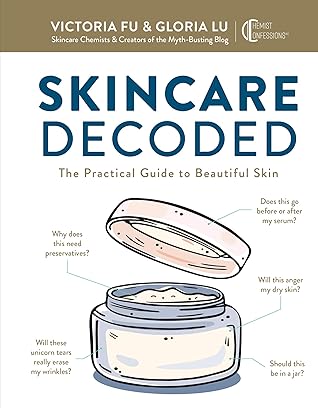More on this book
Kindle Notes & Highlights
Studies have shown that niacinamide boosts ceramide production, reduces hyperpigmentation, and even reduces the severity of acne lesions.
Niacinamide has been clinically demonstrated to effectively treat hyperpigmentation at topical concentrations as low as 2%. What makes niacinamide’s brightening prowess special is the biological pathway that it targets. Unlike most brightening superstars—like hydroquinone, kojic acid, and vitamin C, which work as tyrosinase inhibitors (ahem—more on this on page 198)—this guy actually works downstream from the tyrosinase step to deter pigment transfer. It targets melanosomes and prevents these cells from transferring pigment.
pro—vitamin B5, panthenol, which happens to be a great moisturizing ingredient with multiple hydrating benefits.
•Choose this: Madecassoside, asiaticoside, asiatic acid, madecassic acid •Not that: Centella asiatica extract, centella asiatica leaf water
Choose this: Bisabolol •Not that: Chamomilla recutita (matricaria) flower oil
•Choose this: Tetrahydrodiferuloylmethane, tetrahydrocurcumin diacetate, Curcuma longa root extract •Not that: Turmeric essential oil
Resveratrol: This is the antioxidant found in grapes. A lot of brands will tout it as an ingredient but don’t use enough to have any real effect. Look for more derm-or science-backed brands that have a concentration of around 0.5%.
Lipoic acid: We’ve seen a good study showing that 5% lipoic acid can effectively reduce signs of photoaging. Given the high use level, we wouldn’t recommend choosing a product that has lipoic acid lower than the fifth position in an ingredient list. CoQ10: This is the abreviation for “coenzyme Q10,” also known as ubiquinone. It is a natural and integral part of your cell function and is an important part of your skin’s natural defense system against outside aggressors. Topically, you need about 0.5% CoQ10, ideally in combination with vitamin E.
the more established trade names in the peptides world, such as Matrixyl and Haloxyl.
Mandelic acid. Don’t worry about having to settle for a lukewarm AHA situation that aggravates dry patches while not quite tackling your oily zones. Mandelic acid hits the right balance—gentle on dry skin and yet still great for oily combination skin.
Skin protectants: Colloidal oatmeal and allantoin have such a good track record, they are considered by the FDA to be “skin protectant” ingredients. They are effective ingredients that can help ease irritation in the long run.
Botanical soothers: There are a lot of plant-based soothers to consider in skincare! Some chemist favorites to consider include madecassoside and bisabolol.
In your day routine, you have two possible steps for acne ingredients: cleanser and treatment step. For daytime, try to keep it simple with ingredients like salicylic acid and benzoyl peroxide. One product that acne-prone skin types purposely like to forget is sunscreen. We get it—the texture, shine, and oiliness makes you want to do a hard pass, but sunscreen is really important for postacne healing. Too much sun can lead to those spots darkening. On top of that, a lot of these acne-fighting ingredients make you more sensitive to the sun, so let’s sunscreen, people!
Melanocytes are skin cells that live in the deepest part of your epidermis and are, in a nutshell, your skin’s one-stop-shop for pigment. Through a process called melanogenesis, each melanocyte produces, packages, and delivers melanin to the skin’s upper layers, where it becomes visible pigmentation.
Tyrosinase! One of the most important enzymes in this process, tyrosinase determines how fast melanin is produced—and when it comes to melanogenesis, “how fast” is crucial. Uneven skin tone, melasma and hyperpigmentation are all linked to overly enthusiastic melanin production.
consider replacement ingredients such as silymarin, lipoid acid, resveratrol, or magnesium ascorbic phosphate.
Many pigment-fighting serums contain a blend of tyrosinase-targeting ingredients, however. So, use the list as a general guide, but always patch-test! •Milder: Licorice root, Uva ursa (bearberry), peony extract •Medium: Arbutin, kojic acid, azelaic acid, tranexamic acid, resorcinol, ascorbyl glucoside •Heavy duty: Hydroquinone
We classify these hyperpigmentation fighters into three general ingredient categories: isolated compounds, multitaskers, and botanical brighteners.
chronoaging is associated with thinning skin and loss of elasticity.
Collagen: This protein, with its sturdy triple-helix coil structure, is the crucial support protein in your dermis.
of aging pathways such as free radical damage, glycation caused by excess sugar, elastosis (elastin buildup),
Matrixyl 3000: You can find this on your ingredient list as palmitoyl tripeptide-1 and palmitoyl tetrapeptide-7, or even called out directly on the packaging. This is one of the most well-known peptides out there, created by Sederma, which has done multiple clinicals to showcase that Matrixyl can visibly reduce the appearance of wrinkles.
Haloxyl: This is another Sederma classic! Unlike Matrixyl, it has been tested more specifically for eye-area concerns such as dark circles and firmness around the eye area. You can spot this on your ingredient list as hydroxysuccinimide, palmitoyl tripeptide-1, and palmitoyl tetrapeptide-7.
sh-Oligopeptide-1 : This is one of the main ingredients found in products claiming “growth factor” benefits. It can be found alon...
This highlight has been truncated due to consecutive passage length restrictions.
certain chemical sunscreen filters may have an impact on coral reefs, specifically oxybenzone and octinoxate.


